Producers suffer considerable economic losses due to heat stress(St-Pierre, Cobanov, & Schnitkey, 2003). Due to global warming, more hot days and more days of extreme heat are expected for the near future, which aggravates the issue even more.
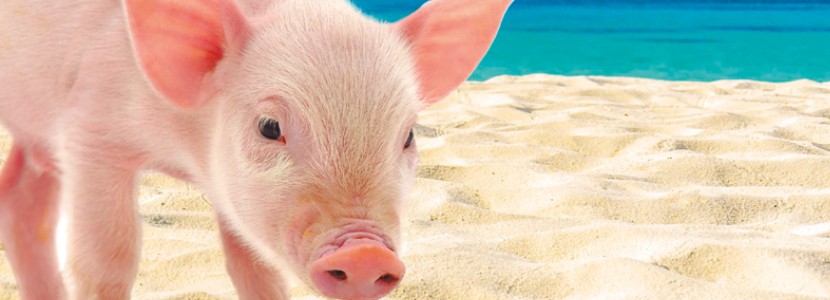 01 Feb 2023
01 Feb 2023
Heat stress management in pigs during summer.
The end of winter and the arrival of warmer temperatures remind us about the importance of reviewing the effects of heat stress in pigs, and how to mitigate it.
Producers suffer considerable economic losses due to heat stress(St-Pierre, Cobanov, & Schnitkey, 2003). Due to global warming, more hot days and more days of extreme heat are expected for the near future, which aggravates the issue even more.
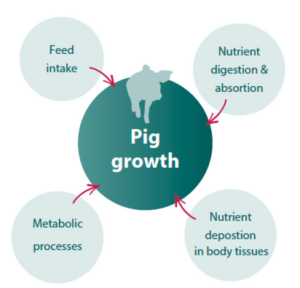
Environmental temperature reduces pig growth
Pig growth is a complex biological process involving feed consumption, nutrient digestion and absorption, metabolic processes involving nutrient conversion for the maintenance of physiological processes and tissues. As well as nutrient deposition in various tissues promoting overall growth– van Milgen et al., 2012.
All of these metabolic processes are aimed at transforming dietary energy into meat –Labussière, Dubois, van Milgen, & Noblet, 2013–.
![]()
The laws of thermodynamics indicate that part of the energy involved in chemical reactions is lost in the form of caloric increments (Holdsworth, 1971).
This caloric increase must be dissipated by the pig in order to prevent hyperthermia –Kearney, Simpson, Raubenheimer & Kooijman, 2013–.
Thermoneutral zone
The thermoneutral zone is defined as the environmental temperature range that allows the pig to passively dissipate its caloric increase. When the environmental temperature increases, pigs need to actively dissipate their caloric increase.
Pigs carry out caloric dissipation through:
Maximum critical temperature
The temperature at which pigs need to actively dissipate heat is known as the maximum critical temperature.
One of the main strategies that pigs use to decrease caloric increments, is reducing their feed intake. This is due to the fact that reduced feed intake decreases metabolic processes and the subsequent caloric increase associated with such processes –Renaudeau, Gilbert, & Noblet, 2012–.
Management strategies for reducing hyperthermia effects
The most effective way to reduce environmental temperature impacts on pig growth is through the management of temperature and relative humidity within feedlot sheds.
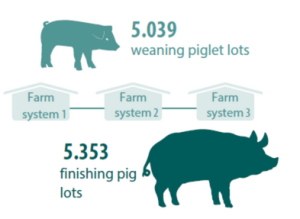
![]()
However, a recent assessment of production data from 5,039 weaning piglet lots and 5,353 finishing pig lots across three pig farm systems suggests that there are large differences between production systems. This suggests that there is still space for improvement in certain production systems regarding their current management practices. 2019–.
Not all production systems are able to mitigate environmental temperature effects through the sole use of ventilation systems and modifications to the physical environment. Therefore, it necessary to look for other other mitigation strategies, such as feed management – Renaudeau, Collin, et al. , 2012–.
Dietary management to prevent productive losses due to hyperthermia
The most commonly described measures within scientific literature, focus on reducing caloric increase through dietary manipulation–Coffey, Seerley, Funderburke, & Mccampbell, 1982–.
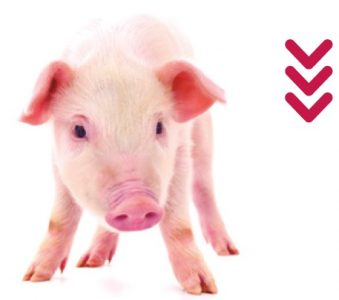
Nutrients possess different effects on caloric increase as energy sources
New tools and strategies for heat stress mitigation
Pig metabolome under heat stress
Despite multiple efforts and ongoing research, there are still significant growth losses during summer months.
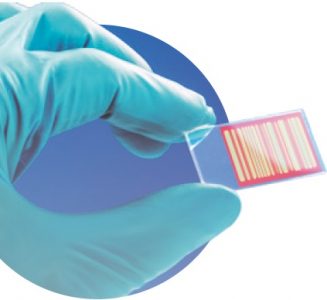
In an effort to better understand metabolic events during episodes of hyperthermia we conducted an experiment using metabolome analysis, guided by the use of liquid chromatography and mass spectroscopy –Wang et al. , 2016–.
![]()
A second objective for this experiment was to evaluate if dietary addition of organic zinc caused increases or reductions in heat stress effects.
Figure 1. Experimental design and response of pigs to heat stress (A, B)
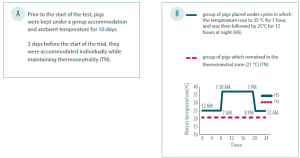
Results
As expected, pigs within the thermoneutral zone grew normally while their feed intake was similar to that of pigs in other experiments on the same farm. On the other hand, pigs subjected to heat stress cycle(35/25 °C) presented difficulties for dissipating caloric increase and their body temperature surpassed the temperature of those within the thermoneutral zone –Figure 1, panels C and D–.
Figure 1. Experimental design and response of pigs to heat stress (C, D)
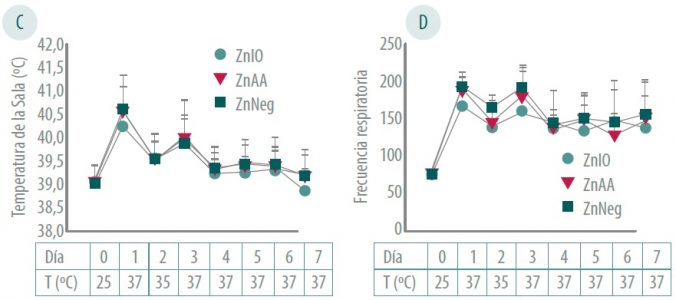
Pigs in 35/25 cycles also responded with reduced feed intake and decreased growth –Figure 1, panels E, F, and G.
Figure 1. Experimental design and response of pigs to heat stress (E, F, G)
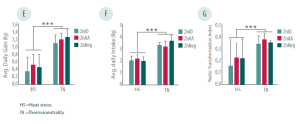
Interestingly, pigs in 35/25 cycles presented a different set of blood metabolites compared to those found in pigs within the thermoneutral zone –Figure 2–.
Figure 2. Metabolomic profile of pigs at heat stress; lipids (panel A) and amino acids (panel B), blood concentration of uric nitrogen (panel C) and creatinine (panel D)
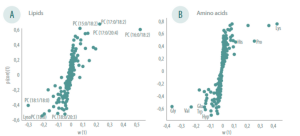
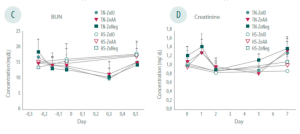
These metabolite changes were also evident in changes of multiple lipids and amino acids.
The concentration of urea nitrogen and creatinine in the blood of pigs under heat stress was higher than that of pigs in the thermoneutral zone.
The metabolic profile of pig urine and feces under heat stress also showed important changes.
| These observations coincide with data evaluating intestinal barrier resistance –Pearce et al., 2013– and the potential role of catecholamines in intestinal damage during heat stress –Lyte & Lyte, 2019–. |
Illustration 3. Metabolomic profile of thermoneutral (TN) and caloric (HS) pigs fed inorganic zinc (ZnIO), organic zinc (ZnAA) and no additional zinc (ZnNeg)
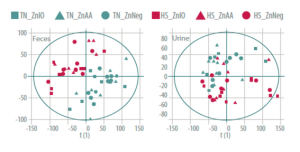
Metabolome of pigs resistant to heat stress
The use of metabolomic profiles has been proposed as another tool for predicting which pigs have greater resistance to heat stress.
![]() Robust individuals for hot climates
Robust individuals for hot climates
These individuals were selected through the crossing of Creole and Large White breeds. These were fed and raised in experimental stations with tropical and temperate climates –Dou et al., 2017–.
The use of the metabolome as a tool, has allowed the characterization of the metabolic profile of pigs under heat stress. Making it useful for the selection of animals with greater adaptability to higher environmental temperatures.
| In conclusion, it can be said that pigs need to maintain a balance between caloric increase and environmental temperature. When environmental temperature rises to levels where it limits pigs’ ability to grow, it becomes necessary to manipulate their diet. The use of the metabolome has allowed to study the complex metabolic changes occurring in pigs under caloric stress. This can lead to the development of new feed strategies that can minimize heat stress through the use of innovative methods. |
You may also like: “Heat stress: Poultry health, performance and potential mitigation strategies.”
Subscribe now to the technical magazine of animal nutrition
AUTHORS

Nutritional Interventions to Improve Fertility in Male Broiler Breeders
Edgar Oviedo
The Use of Organic Acids in Poultry: A Natural Path to Health and Productivity
M. Naeem
Synergistic Benefits of Prebiotics and Probiotics in Poultry, Swine, and Cattle
Gustavo Adolfo Quintana-Ospina
Hybrid Rye Potential in Laying Hen Feed Rations
Gwendolyn Jones
A day in the life of phosphorus in pigs: Part I
Rafael Duran Giménez-Rico
Use of enzymes in diets for ruminants
Braulio de la Calle Campos
Minerals and Hoof Health in the Pregnant Sow
Juan Gabriel Espino
Impact of Oxidized Fats on Swine Reproduction and Offspring
Maria Alejandra Perez Alvarado